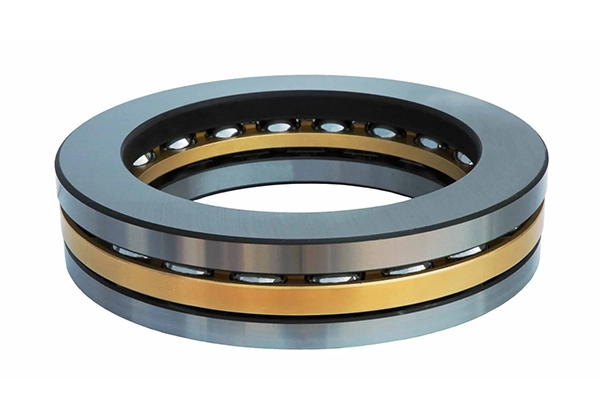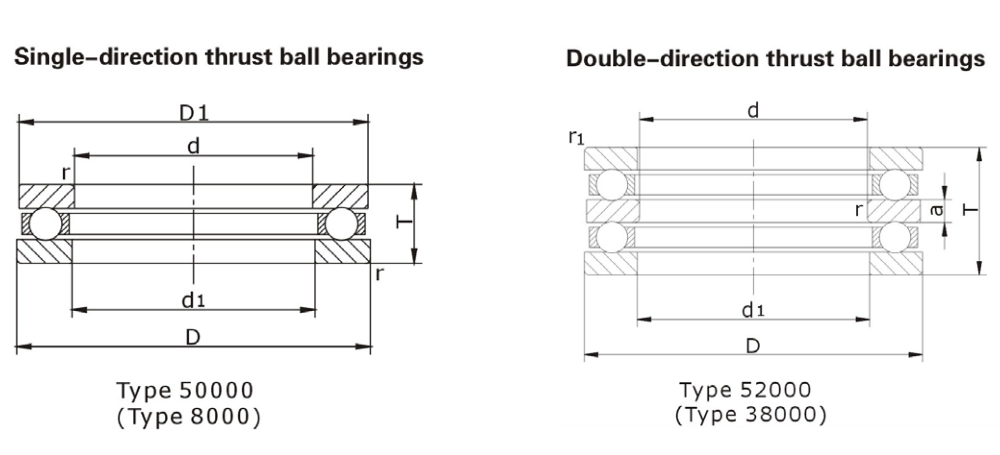Why Thrust Ball Bearings Are Key to Reliable Performance in Industrial Machinery?
In today's industrial landscape, the reliability and efficiency of machinery depend heavily on their components, with thrust ball bearings playing a crucial role in maintaining optimal performance. These precision-engineered components are fundamental to various industrial applications, serving as the backbone of mechanical systems that require smooth axial load handling and rotational movement. The integration of thrust ball bearings into modern machinery has revolutionized the way equipment handles axial loads, significantly improving operational efficiency and equipment longevity.

Luoyang Huigong Bearing Technology Co., Ltd., backed by an experienced R&D team, provides technical guidance and customized solutions for different operating conditions. With 30 years of industry experience and partnerships with major enterprises, the company utilizes advanced production equipment and testing instruments. Boasting over 50 invention patents and certifications including ISO9001 quality management system and ISO14001 environmental management system, Luoyang Huigong has been recognized as a quality benchmark enterprise in 2024. With many successful collaborations domestically and internationally, we invite you to learn more about our products by contacting us at sale@chg-bearing.com or calling our hotline at +86-0379-65793878.
How Do Thrust Ball Bearings Compare to Other Types of Thrust Bearings?
Thrust ball bearings distinguish themselves from other varieties through their unique design and performance characteristics. While cylindrical roller thrust bearings excel in handling heavy axial loads and can support weights ranging from 75 to 274kg, thrust ball bearings offer superior performance at higher speeds. The key difference lies in their contact mechanics – ball bearings provide point contact, whereas roller bearings offer line contact. This fundamental difference affects everything from load distribution to heat generation during operation.

Comparing specific types:
- Cylindrical roller thrust bearings feature separable components and superior load capacity but are limited to unidirectional axial loads and lower speeds due to roller slippage. Their design makes them particularly suitable for applications where heavy loads are the primary concern. The separable design also facilitates easier maintenance and installation procedures.
- Tapered roller thrust bearings demonstrate higher loading capacity than cylindrical variants but operate at lower speeds. Their unique geometry allows them to handle combined loads effectively, making them ideal for applications where both axial and radial loads are present. The tapered design also helps in maintaining proper lubrication film thickness during operation.
- Spherical roller thrust bearings offer self-aligning capabilities, making them ideal for applications where misalignment might occur. This self-aligning feature proves invaluable in situations where shaft deflection or housing deformation could otherwise lead to premature bearing failure.
The manufacturing process for each bearing type involves specific considerations and tolerances:
- Precision grinding of raceways
- Surface finish requirements
- Material selection based on application
- Heat treatment processes
- Assembly and quality control procedures

What Makes Thrust Ball Bearings Essential for Industrial Applications?
The versatility of thrust ball bearings makes them indispensable in industrial machinery, representing a critical advancement in modern manufacturing and equipment design. Their sophisticated design accommodates an impressive range of sizes, featuring inner diameters spanning from 200mm to 380mm and outer diameters extending from 400mm to 670mm. This remarkable size flexibility enables their implementation across an extensive spectrum of applications, seamlessly integrating into both precision-dependent smaller equipment and robust large-scale industrial machines. The adaptability of these bearings has revolutionized how engineers approach mechanical design challenges, offering solutions that combine efficiency with reliability.
One of the most significant advantages of thrust ball bearings lies in their superior friction characteristics compared to roller thrust bearings. This reduced friction translates directly into operational benefits, significantly decreasing energy consumption and heat generation during operation. In high-speed applications, particularly those demanding high RPM performance, thrust ball bearings demonstrate exceptional capability, maintaining stability and precision even under challenging operational conditions. Their design excellence particularly shines in precision applications where accurate positioning is paramount, making them the preferred choice for manufacturers requiring precise control and repeatability in their processes.
The thermal management capabilities of thrust ball bearings represent another crucial advantage, achieved through their optimized contact geometry. This sophisticated design facilitates superior heat dissipation, preventing temperature-related issues that could otherwise compromise equipment performance. Additionally, their simplified yet robust construction significantly reduces maintenance requirements, leading to lower operational costs and increased equipment uptime. This combination of thermal efficiency and reduced maintenance needs makes them particularly valuable in continuous operation environments where reliability is critical.
Material selection plays a pivotal role in the performance excellence of thrust ball bearings. The incorporation of premium materials such as GCr15, GCr15SiMn, and G20Cr2Ni4A establishes new standards in bearing durability and reliability under demanding conditions. These carefully selected materials undergo rigorous optimization processes to achieve enhanced wear resistance through refined microstructural properties. The sophisticated heat treatment processes these materials undergo result in superior fatigue strength, ensuring extended service life even under challenging operational conditions. Their improved thermal stability across broad temperature ranges makes them suitable for diverse industrial applications, while their enhanced corrosion resistance proves invaluable in challenging environmental conditions. Perhaps most importantly, these materials maintain consistent performance characteristics under varying load conditions, providing reliable operation throughout their service life.
The evolution of manufacturing techniques has significantly enhanced thrust ball bearing capabilities, introducing innovations that push the boundaries of performance and reliability. Advanced surface finishing methods now achieve unprecedented levels of smoothness and precision, dramatically reducing friction and wear while extending bearing life. State-of-the-art precision dimensional control ensures perfect compatibility and optimal performance in all applications. The implementation of innovative heat treatment processes has revolutionized material properties, creating bearings with superior hardness, durability, and dimensional stability. Enhanced quality control procedures, utilizing advanced measurement and testing equipment, guarantee that each bearing meets or exceeds stringent performance specifications. Furthermore, improved material homogeneity through refined manufacturing processes ensures consistent performance characteristics across entire production batches, providing users with reliable and predictable bearing behavior throughout their operational lifetime.
These advancements in thrust ball bearing technology continue to drive innovation in industrial machinery design, enabling the development of more efficient, reliable, and high-performing equipment across various sectors. The combination of sophisticated materials, advanced manufacturing techniques, and optimized design features makes thrust ball bearings an essential component in modern industrial applications, supporting the growing demands for increased productivity and reliability in industrial operations.
What Are the Critical Factors in Selecting the Right Thrust Ball Bearing?
The selection of appropriate thrust ball bearings represents a complex decision-making process that demands careful consideration of multiple interrelated factors, each critically impacting performance and reliability. Operating conditions stand as the primary consideration, encompassing crucial elements such as speed requirements and limitations, load characteristics including both dynamic and static loads, temperature conditions and thermal management strategies, environmental factors including contamination and moisture exposure, and specific lubrication requirements. These operational parameters form the foundation of the selection process, determining the bearing's ability to perform reliably under real-world conditions.
Cage design emerges as another crucial consideration in the selection process, with various options available to meet specific application requirements. Metal machined solid cages, predominantly used in standard applications, offer robust performance and reliability. For specialized applications requiring specific material properties, steel or brass cages provide targeted solutions. Custom cage designs address unique application requirements, while material selection for cages must align precisely with operating conditions. The optimization of cage design for lubrication retention and distribution plays a vital role in maintaining bearing performance and longevity, ensuring smooth operation throughout the bearing's service life.
Application-specific considerations further refine the selection process, particularly in specialized industries with unique demands. Heavy machine tools require exceptional precision and load capacity, while marine equipment demands superior corrosion resistance. Construction machinery applications focus heavily on shock load handling capabilities, and power generation equipment necessitates reliable continuous operation. These industry-specific requirements often intersect with environmental considerations, particularly in extreme conditions where standard solutions may prove inadequate.
The comprehensive selection process extends beyond basic operational requirements to encompass practical considerations that impact long-term performance and maintenance. Dimensional constraints must align precisely with application requirements, while lubrication systems must demonstrate compatibility with existing infrastructure. Maintenance accessibility and service intervals require careful planning to ensure optimal performance throughout the bearing's lifecycle. Cost-effectiveness calculations must consider not just initial investment but total ownership costs, including maintenance and potential downtime. Installation requirements, mounting procedures, and sealing solutions all play crucial roles in ensuring proper bearing function and protection.
Industrial implementation examples across various sectors demonstrate the diverse applications and specific requirements of thrust ball bearings. In the machine tools industry, applications range from precision spindle support requiring exceptional accuracy to table positioning mechanisms demanding smooth operation. Feed drive systems, cutting tool support applications, and grinding wheel assemblies each present unique challenges requiring specific bearing characteristics. Maritime applications present particularly demanding conditions, with propulsion systems operating under heavy loads and deck machinery exposed to harsh marine environments. Auxiliary equipment, steering gear mechanisms, and winch and hoist systems each require carefully selected bearings to ensure reliable operation in challenging conditions.
Construction equipment applications further illustrate the breadth of thrust ball bearing applications, with excavator swing bearings handling varying loads and crane turntable bearings demanding precise operation. Concrete pump supports must effectively manage vibration, while earth-moving equipment and drilling machinery present their own unique set of requirements. Each application demands careful consideration of specific operating conditions and performance requirements to ensure optimal bearing selection.
The evolution of bearing technology continues to drive innovation in the field, with manufacturers developing increasingly sophisticated solutions to meet growing industrial demands. Modern thrust ball bearings incorporate advanced sealing technologies providing superior protection against contaminants, improved lubrication systems enhancing performance and reliability, and enhanced material compositions extending service life. Optimized geometric designs improve load distribution characteristics, while innovative cage designs enhance guidance and stability. Superior surface finishes reduce friction and wear, and enhanced heat treatment processes improve overall durability and performance.
Through this comprehensive approach to bearing selection, engineers can ensure optimal performance and reliability in specific applications. The selection process must integrate detailed analysis of application requirements, careful consideration of operating environments, thorough evaluation of maintenance capabilities, comprehensive assessment of cost implications, and rigorous review of safety factors. This systematic approach, combined with ongoing technological advancements, ensures that thrust ball bearings continue to meet the evolving needs of modern industrial applications, maintaining their position at the forefront of industrial machinery performance and reliability.
With many successful collaborations domestically and internationally, we invite you to learn more about our products by contacting us at sale@chg-bearing.com or calling our hotline at +86-0379-65793878.
References:
1. SKF Bearing Technical Manual (2023)
2. Timken Engineering Manual (2023)
3. Journal of Tribology International, "Advances in Bearing Technology" (2023)
4. American Bearing Manufacturers Association Standards (2024)
5. International Organization for Standardization - ISO 104:2023 Rolling Bearings
6. Machine Design Guidelines for Bearing Applications (2023)
7. Industrial Maintenance & Plant Operation Handbook (2024)
8. Mechanical Engineering Design Standards (2023)

